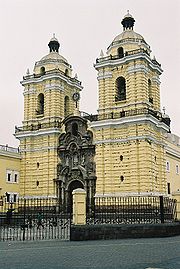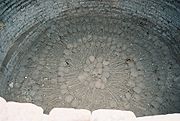
Convento de San Francisco
Encyclopedia



Lima
Lima is the capital and the largest city of Peru. It is located in the valleys of the Chillón, Rímac and Lurín rivers, in the central part of the country, on a desert coast overlooking the Pacific Ocean. Together with the seaport of Callao, it forms a contiguous urban area known as the Lima...
, Peru
Peru
Peru , officially the Republic of Peru , is a country in western South America. It is bordered on the north by Ecuador and Colombia, on the east by Brazil, on the southeast by Bolivia, on the south by Chile, and on the west by the Pacific Ocean....
at Ancash, south of Parque la Muralla and one block northeast from the Plaza Mayor. The church and convent are part of the Historic Centre of Lima, which was added to the UNESCO World Heritage List in 1991. Aside from a church and monastery it also contains a library and catacombs. In this church, Jude the Apostle is venerated. At the feast of Saint Jude Tadeus a one and a half ton weighing silver stand is carried round in procession by 40 people, starting from the convent.
Architecture
The church and monastery were consecrated in 1673 and completed in 1774. Though it survived several earthquakes intact in 1687 and 1746, it suffered extensive damage in an earthquake in 1970. The church is noted for its architectureArchitecture
Architecture is both the process and product of planning, designing and construction. Architectural works, in the material form of buildings, are often perceived as cultural and political symbols and as works of art...
, a high example of Spanish Baroque
Baroque
The Baroque is a period and the style that used exaggerated motion and clear, easily interpreted detail to produce drama, tension, exuberance, and grandeur in sculpture, painting, literature, dance, and music...
. Its granite carved portal would later influence those on other churches, including the Church of Merced. The vaults of the central and two side naves
Navès
Navès is a commune in the Tarn department in southern France.-Geography:The Thoré forms most of the commune's north-eastern border, then flows into the Agout, which forms part of its northern border.-References:*...
are painted in mudejar
Mudéjar
Mudéjar is the name given to individual Moors or Muslims of Al-Andalus who remained in Iberia after the Christian Reconquista but were not converted to Christianity...
style: a mix of Moorish and Spanish designs. The head altar is fully carved out of wood. The corridors of the main cloister are inlaid with Sevillian glazed tiles dating from the 1620s. The complex is made of the temple, the convent and two other churches, 'La Soledad' and 'El Milagro'.
Convent
The convent's library is world-renowned. It possesses about 25,000 antique texts, some of them predating the conquest. Some notable books are the first Spanish dictionary published by the Real Spanish Academia and a Holy Bible edition from 1571- 1572 printed in Antwerp.The staircase towards the library has a spectacular, geometric Moorish-style cuppola in Nicaraguan cedar for a ceiling. It was carved in 1625 and restored in 1969. The choir is positioned on the second floor looking out onto the nave and is made of cedar carved with biblical figures.
Other notable possessions are 13 paintings of the biblical patriarch Jacob and his 12 sons in the refectory, by the hand of the studio of the Spanish master Francisco de Zurbarán. The last supper painted by Diego de la Puente depicts typical Peruvian ingredients and meals, instead of European dishes it depicts, such as guinea pig, potatoes and chillis. Also peculiar is the Devil hovering besides Judas. The monastery also possesses several paintings attributed to the school of Pieter Paul Rubens
Catacombs
Lima's first cemetery were the CatacombsCatacombs
Catacombs, human-made subterranean passageways for religious practice. Any chamber used as a burial place can be described as a catacomb, although the word is most commonly associated with the Roman empire...
below the monastery contain an ossuary
Ossuary
An ossuary is a chest, building, well, or site made to serve as the final resting place of human skeletal remains. They are frequently used where burial space is scarce. A body is first buried in a temporary grave, then after some years the skeletal remains are removed and placed in an ossuary...
and some secrete passageways are said to connect to the cathedral
Cathedral
A cathedral is a Christian church that contains the seat of a bishop...
and the Tribunal of the Inquisition. The catacombs remained in use until 1808 when a city cemetery outside of Lima was started. The catacombs were discovered in 1943. It is estimated to contain 70,000 burials. Bones line up along narrow hallways underneath the church, and one area contains several large and deep holes, filled with bones and skulls arranged above each other in circular patterns.
See also
- Historic Centre of LimaHistoric Centre of LimaLocated principally in the city centre or Cercado de Lima and Rímac areas, the Historic Centre of Lima is among the most important tourist destinations in Peru.-Foundation:...
- 360° visual of the church

